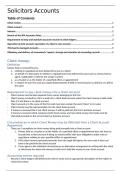Summary
Summary SQE 1 - Solicitors Accounts Revision Notes (FLK 2)
- Course
- Institution
Passed Jan 2024 SQE 1 first try (1st Quintile) using these notes. Summarises everything you need to know for the Solicitors Accounts aspect of the SQE 1 exam, including details of double-entry book-keeping and specific entries relating to different situations. Carefully curated summary notes, alig...
[Show more]



